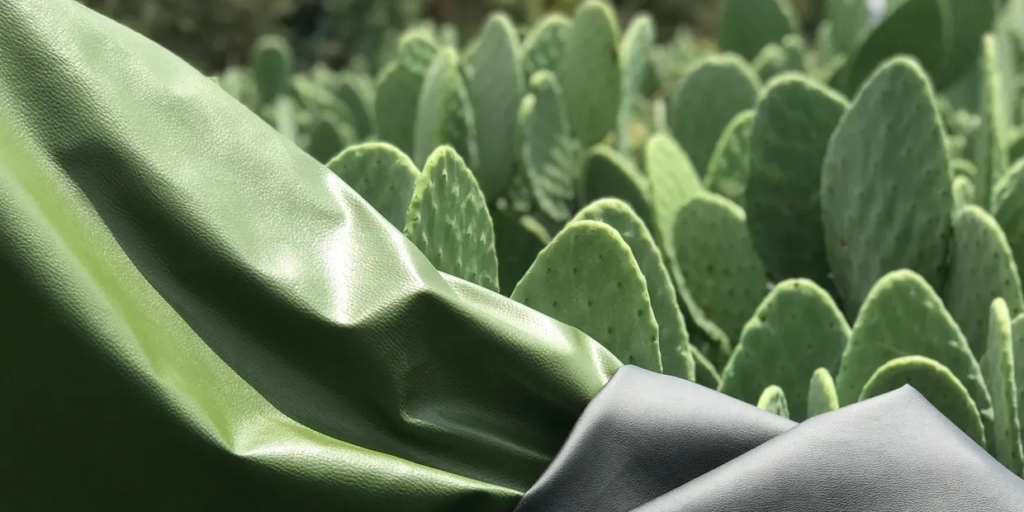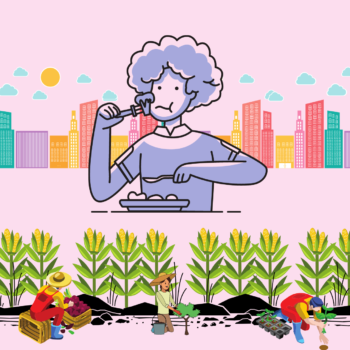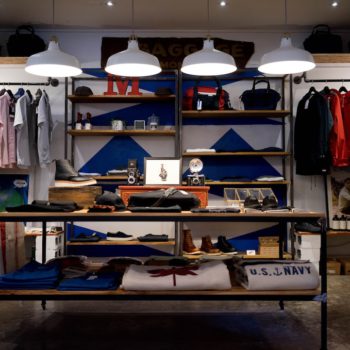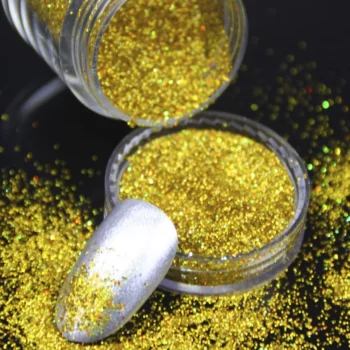|
|
We see and use leather everywhere–adorning our footwear and handbags to belts and knife sheaths. Yet, in a world increasingly aware of this material’s environmental and ethical implications, more and more consumers are demanding cruelty-free alternatives to animal-based leather.
Enter cactus leather, a revolutionary material that promises to redefine our approach to fashion and beyond with its eco-friendly credentials and cruelty-free production. Let’s explore cactus leather to understand its origins, benefits, and potential for a more sustainable future.
Key Takeaways
-
- The market for traditional leather is one of the most prominent and influential industries globally, valued at USD 242.85 billion in 2022.
-
- Despite traditional leather’s durability and aesthetic appeal, its production has a massive carbon footprint due to methane emissions, land and water usage, and the deforestation associated with creating pasture.
-
- Leather tanning, a necessary step to prevent the material’s decomposition, often uses toxic chemicals like chromium, which can pollute waterways and harm the ecosystem and the people working within the industry.
-
- Cactus leather is a sustainable and vegan alternative to animal-based leather made from the Nopal cactus.
-
- It offers significant environmental benefits, including minimal water use, biodegradability, and a non-toxic production process.
-
- Cactus leather matches the durability and aesthetics of traditional leather, making it suitable for a wide range of applications.
-
- Several brands have begun incorporating cactus leather into their products, signaling a growing trend toward sustainable materials.
-
- The future for cactus leather looks promising, with the potential for increased adoption and innovation, leading to more eco-friendly and ethical products.
A Look Into the Leather Industry
The market for traditional leather is one of the most prominent and influential industries globally. Its reach extends across various sectors, from fashion and accessories to automotive and furniture. This ubiquity highlights leather’s integral role in our daily lives and its status as a symbol of luxury and durability.
According to the Grand View Research, in 2022, the global leather goods market was valued at USD 242.85 billion. Projections suggest a robust compound annual growth rate (CAGR) of 6.6% from 2023 to 2030. This anticipated growth is attributed to several key factors: rising disposable incomes and the elevation of consumer living standards worldwide, shifts in fashion trends that continue to place leather goods in high demand, and a surge in domestic and international travel.
Furthermore, the market’s expansion is fueled by an increasing consumer preference for leather items that combine comfort with luxury, alongside a heightened awareness and loyalty towards specific brands.

Image Source: https://www.grandviewresearch.com/industry-analysis/leather-goods-market
Despite the widespread appeal of traditional leather and the industry’s promising growth forecasts, a more troubling reality casts a shadow over this success: the leather industry is fraught with significant environmental and social challenges.
As the World Economic Forum puts it:
“Traditional leather production is a land-intensive process that produces large amounts of greenhouse gases and uses dangerous chemicals to tan animal skin.”
Creating animal-based leather involves a complex, multi-step procedure that typically includes preparation, tanning, crusting, and, occasionally, an additional finishing stage. The hides undergo preparation, removing hair, fat, and meat to make them suitable for tanning.
Tanning is crucial as it converts the skins into durable, flexible leather, effectively preventing decomposition. Following tanning, the crusting phase thins, dries, softens, and dyes the hides using a combination of chemicals and mechanical treatment.
Gizmodo explains that distinguishing between tanned hide and rawhide is straightforward based on their responses to heat and moisture. Rawhide hardens under heat and decomposes when moistened again, whereas tanned leather retains its flexibility in heat and doesn’t decompose if wet. The choice of tanning method is crucial, as it influences the leather’s final characteristics and applications, including:
-
- Vegetable-tanned leather is created using plant-derived tannins like tree bark, producing soft, brown leather perfect for carving and stamping. However, it reacts poorly to water, shrinking and hardening significantly, which historically made it practical for early plate armor and bookbinding.
-
- Synthetic-tanned leather employs aromatic polymers such as Novolac and Melamine. Developed during World War II due to a shortage of vegetable tannins, this leather is recognizable by its creamy white hue.
-
- Alum-tanned leather and Rawhide are traditionally not seen as tanned materials because they spoil in water. Alum leather, made with aluminum salts and binding agents like egg yolks, allows for lighter colors but is less flexible. Rawhide, produced by scraping, liming, and drying the skin, is used for products requiring a stiffer material, like drum heads and shoelaces.
-
- Aldehyde-tanned leather, an alternative to chromium-based tanning, uses chemicals like glutaraldehyde for a water-absorbent, soft leather that is machine washable, making it ideal for chamois products.
-
- Chromium-tanned leather is the most widespread and environmentally detrimental method, using chromium salts to produce a supple, light blue leather. The process involves pickling hides in chromium to lower their pH, then soaking them in tanning liquor to fix the tanning agents at a molecular level, minimizing shrinkage when exposed to warm water.
The environmental toll of these procedures is significant, however. The chemicals used, particularly during the tanning and crusting stages, include harmful substances such as chromium—a heavy metal that plays a crucial role in the tanning process. The aftermath involves generating waste laden with carcinogenic compounds, posing severe health and environmental risks.
Unfortunately, in regions with lax environmental regulations, such as India, China, and Bangladesh, this toxic waste frequently finds its way into local water bodies, contaminating ecosystems, endangering aquatic life, and impacting communities dependent on these water sources for their daily needs.
Beyond the environmental toll, working within tanneries also poses significant dangers due to inadequate worker protection. Hazards include slips and falls on poorly drained floors, exposure to harmful chemicals like lime and tanning liquor, and the risk of injury from heavy machinery or sharp tools. Handling chromium, in particular, is perilous. Inhalation can lead to respiratory issues and increase cancer risk, while skin contact may cause dryness, ulcers, and allergic reactions. Raw hides can also harbor anthrax, though this risk has primarily been mitigated in Western tanneries through disinfection processes.
The following video by Danwatch delves into the working conditions within the Indian tanning industry, shedding light on workers’ health implications due to the tanning process.
Vegan Alternatives to the Rescue
In response to the environmental and ethical concerns posed by the leather industry, several sustainable, vegan alternatives have emerged. Materials like Piñatex, made from pineapple leaf fibers, and mushroom leather from mycelium offer innovative and less harmful options. However, many of these alternatives still face challenges regarding durability, feel, and appearance compared to traditional leather. That is where cactus leather comes into play.
As a relatively new entrant into the vegan leather market, cactus leather, mainly the brand Desserto, has quickly gained attention for its remarkable qualities that mimic those of animal leather without the heavy environmental and ethical toll.
| Sustainable Vegan Alternatives | Material | Source |
|---|---|---|
| Piñatex | Pineapple leaf fibers | Pineapple industry waste |
| Mushroom leather | Mycelium | Fungi cultivation |
| Cactus leather (Desserto) | Nopal cactus | Cactus leaves |
Introducing Cactus Leather

Image Source: https://desserto.com.mx/home
Cactus leather, a sustainable and vegan material, was created by Adrián López Velarde and Marte Cázarez in Mexico. This innovative material is made from the Nopal cactus (the prickly pear), renowned for its hardy nature and minimal water requirements.
Adrian and Marte, with backgrounds in automotive and fashion, recognized the detrimental environmental impact of these industries. Motivated to shift from animal leather to a sustainable alternative, they researched materials extensively. Their exploration led them to the Nopal cactus, whose protein content created a paste-like leather suitable for various products.
Nopal’s abundance and minimal irrigation needs in Mexico made it an ideal base. Harvesting occurs every 6 to 8 months, with plantations refreshed every eight years. Each hectare yields 200 tons of nopal leaves, producing 1 square meter of vegan leather from every 3 kilograms.
This research culminated in the founding of Desserto, pioneering the production of cactus leather.
Production Process
The process involves harvesting mature Nopal cactus leaves without harming the plant, letting it regenerate for future harvests. These leaves are then cleaned, mashed, and sun-dried before being processed into a durable, flexible material that boasts many of the same qualities as traditional leather, including breathability, resistance, and a pleasing aesthetic.
Here is a video from Bloomberg Quicktake showing how Desserto turns cactus into leather
Your Weekly Sustainability News!
By subscribing you agree to our Privacy Policy
Advantages
Cactus leather offers several compelling advantages over both traditional animal leather and other vegan alternatives:
-
- Sustainability: The Nopal cactus is drought-resistant and can grow in arid conditions with minimal water, making cactus leather a highly sustainable option.
-
- Biodegradability: Unlike synthetic leather alternatives that rely on plastics, cactus leather is partially biodegradable, thanks to its natural plant-based origin.
-
- Non-toxic: The production process is free from toxic chemicals, reducing pollution and making it safer for workers and consumers.
-
- Cruelty-free: No animals are harmed in making cactus leather, appealing to consumers looking for ethical alternatives.
-
- Durability and Aesthetics: Cactus leather matches traditional leather’s durability and visual appeal, making it suitable for a wide range of applications, from fashion to automotive interiors.
Some Notable Brands Using Cactus Leather
Several forward-thinking brands have started incorporating this material into their products, recognizing the potential of cactus leather. From luxury handbags and accessories to clothing and even footwear, companies are exploring the versatility and appeal of cactus leather. These pioneering brands not only contribute to a more sustainable and ethical fashion industry but also help raise awareness and demand for eco-friendly materials.
-
- Stella McCartney: Renowned for her commitment to sustainability, Stella McCartney has embraced cactus leather in her luxury handbag collections. By incorporating this eco-friendly material, McCartney continues to lead the way in an ethical fashion.
-
- H&M Conscious: As part of its sustainability initiatives, H&M Conscious has introduced products made from cactus leather. The brand’s mainstream adoption helps make eco-friendly fashion accessible to a wider audience.
-
- Matt & Nat: This Canadian brand specializes in vegan leather goods, and they’ve recently expanded their range to include items made from cactus leather. Matt & Nat’s commitment to cruelty-free materials aligns perfectly with the values of environmentally conscious consumers.
-
- LUXTRA: LUXTRA is dedicated to creating sustainable luxury accessories, and cactus leather has become a key component of its collections. The brand’s stylish handbags and accessories showcase the versatility and elegance of this innovative material.
-
- Mireia Playà: Known for stylish and sustainable footwear, Mireia Playà has incorporated cactus leather into its shoe designs. By prioritizing eco-friendly materials, Mireia Playà offers fashion-forward options for conscious consumers.
-
- Hamilton Perkins Collection: This brand uses upcycling materials to create high-quality bags and accessories. By utilizing cactus leather, Hamilton Perkins Collection continues its mission of reducing waste and promoting sustainability in fashion.
-
- Thousand Fell: Thousand Fell produces sneakers made from recycled and sustainable materials, including cactus leather. Their commitment to environmental responsibility extends to every aspect of their manufacturing process.
-
- Ron Dorff: This Swedish-French brand combines Scandinavian minimalism with French elegance in its clothing and accessories. With the introduction of cactus leather, Ron Dorff adds another layer of sustainability to its collections.
-
- Jeane & Jax: Specializing in cruelty-free fashion, Jeane & Jax offers a range of handbags and accessories crafted from vegan materials, including cactus leather. Its designs blend style and sustainability seamlessly.
-
- Viva’s Project: Viva’s Project is dedicated to creating fashionable, eco-friendly accessories. Incorporating cactus leather into its products contributes to a more sustainable future for fashion.
A Broader Impact Beyond Fashion
While cactus leather has made significant inroads into the fashion industry, its potential extends far beyond. The automotive, furniture, and interior design industries, among others, are ripe for transformation with sustainable materials.
Cactus leather’s durability and aesthetic appeal make it an excellent choice for upholstery, car interiors, and other applications where traditional leather has been the standard. As these industries embrace sustainable materials, the impact on the environment, animal welfare, and social responsibility could be profound.
Challenges Faced by Cactus Leather
While cactus leather presents itself as a promising alternative to traditional leather, offering eco-friendly and cruelty-free qualities, its widespread adoption faces several hurdles that must be addressed. These challenges include:
-
- Scalability: As a relatively new material, cactus leather production processes are still being refined, and scaling up production to meet growing demand can be complex.
-
- Raw Material Availability: The availability of raw materials, specifically nopal cactus, may be limited in certain regions, which could affect the consistency and reliability of the supply chain.
-
- Perception: Some consumers perceive cactus leather as inferior to traditional leather despite its advantages, requiring education and marketing efforts.
-
- Regulatory Compliance: Cactus leather must meet industry standards for durability, safety, and environmental impact, necessitating ongoing testing and certification.
-
- Agricultural Risks: Factors like climate change, pests, and diseases can affect cactus cultivation, prompting the need for sustainable farming practices and diversified sourcing.
-
- Production Costs: Early-stage production costs of cactus leather may be higher than traditional or synthetic alternatives, potentially hindering adoption.
Addressing these challenges requires collaboration across the supply chain, investment in research and development, and a commitment from brands, consumers, and policymakers to support the growth of sustainable materials like cactus leather. Despite these obstacles, the potential of cactus leather to revolutionize the fashion industry and reduce its environmental footprint makes it a promising avenue for innovation and progress.
Conclusion
The path forward for cactus leather and other sustainable vegan alternatives is exciting and challenging. It requires a concerted effort from all stakeholders—innovators, consumers, brands, and governments—to realize the full potential of these materials. The journey towards a more sustainable and ethical world is collective, with each choice and innovation paving the way for a future where our goods reflect our values.
As we look to the future, the success of cactus leather is a model for innovation. It exemplifies how creativity, sustainability, and ethics can merge to create products that are both good for the planet and desirable for consumers. The story of cactus leather is still being written, and its chapters are filled with the promise of a more sustainable, compassionate, and innovative world.
Frequently Asked Questions
What are the environmental benefits of cactus leather?
Cactus leather is sustainable because it requires minimal water to grow – only about 200 liters per year compared to the thousands of liters needed for traditional leather production. It also helps reduce carbon dioxide emissions and is biodegradable.
How does cactus leather compare to animal leather?
Cactus leather is a vegan alternative to animal leather, offering a cruelty-free and sustainable option for those looking for ethical fashion choices. It is also more environmentally friendly and breathable than traditional leather.
Are cactus leather products available in the market?
Yes, there are brands that offer cactus leather products, such as bags, shoes, and accessories. One popular brand known for using cactus leather is Desserto.
What makes cactus leather a better alternative to PVC or faux leather?
Cactus leather is a natural material made from the leaves of the nopal cactus plant, while PVC and faux leather are synthetic materials made from harmful chemicals. Cactus leather is biodegradable and has a lower environmental impact.
How often can cactus plants be harvested for making cactus leather?
Cactus plants can be harvested for cactus leather every six to eight months, making it a sustainable source for leather production.
Is cactus leather suitable for making footwear?
Yes, cactus leather is a durable material that can be used to make footwear, such as shoes and sandals. It offers a stylish and eco-friendly alternative to traditional leather shoes.












